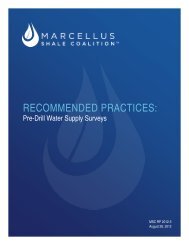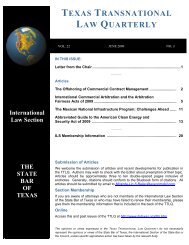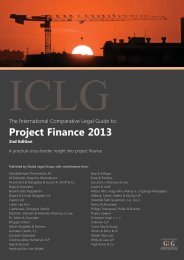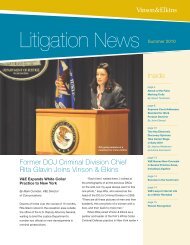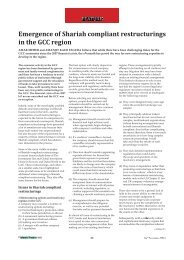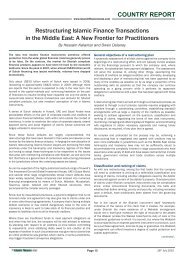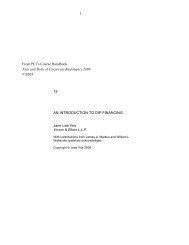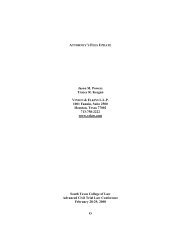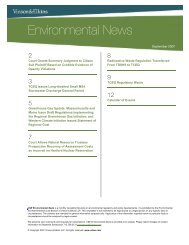Overview of U.S. Export Controls and Sanctions Issues Relating to ...
Overview of U.S. Export Controls and Sanctions Issues Relating to ...
Overview of U.S. Export Controls and Sanctions Issues Relating to ...
You also want an ePaper? Increase the reach of your titles
YUMPU automatically turns print PDFs into web optimized ePapers that Google loves.
Furthermore, while it is unlikely that a U.S. company involved in the development <strong>and</strong> production <strong>of</strong> EVs<br />
would want <strong>to</strong> do business with such a sanctioned entity, a more likely possibility is that a PRC entity<br />
could re-export U.S. origin EV equipment or technology <strong>to</strong> sanctioned countries or individuals (for<br />
example <strong>to</strong> broaden their market share by selling EVs in Iran). The PRC routinely does business with<br />
countries (such as Cuba, Iran, <strong>and</strong> North Korea, etc.) <strong>and</strong> certain individuals (including those<br />
designated as Specially Designated Nationals, or “SDNs,” by OFAC) with whom U.S. persons are<br />
prohibited from doing business. As such, safeguards need <strong>to</strong> be built in<strong>to</strong> any contracts with PRC<br />
companies <strong>to</strong> ensure they agree <strong>to</strong> abide with applicable U.S. export <strong>and</strong> sanctions restrictions. For<br />
example, many compliance-minded companies include a “proceeds” provision in their contracts, <strong>to</strong><br />
ensure that any payments they make are not ultimately used for a purpose that would violate U.S. law.<br />
Although EVs normally should be subject <strong>to</strong> the export controls <strong>of</strong> the EAR, in the event that an EV was<br />
designed or modified for military use (either U.S. military or foreign military), under current U.S. controls,<br />
the resulting vehicle likely would end up being controlled by the more restrictive export controls <strong>of</strong> the<br />
International Traffic in Arms Regulations (the “ITAR”). Under the ITAR, the PRC is a “proscribed<br />
destination,” meaning that PRC companies <strong>and</strong> nationals could not be involved in the development <strong>of</strong><br />
such vehicles <strong>and</strong> the vehicles could not be sold in the PRC. As such, U.S. EV companies should<br />
exercise caution when entering in<strong>to</strong> any arrangements with U.S. or foreign militaries which could<br />
possibly subject their end product <strong>to</strong> ITAR controls.<br />
Notwithst<strong>and</strong>ing these concerns, based on the current state <strong>of</strong> U.S. export <strong>and</strong> sanctions laws <strong>and</strong><br />
regulations, U.S. companies should be able <strong>to</strong> engage PRC companies <strong>and</strong> individuals on EV design,<br />
development, <strong>and</strong> production issues as long as they implement appropriate compliance plans <strong>to</strong><br />
mitigate areas <strong>of</strong> potential risk.<br />
II.<br />
U.S. <strong>Export</strong> <strong>Controls</strong> <strong>and</strong> <strong>Sanctions</strong>: Key Concepts<br />
U.S. export control laws <strong>and</strong> regulations broadly control exports <strong>to</strong> foreign persons. In addition, OFAC<br />
also broadly controls a range <strong>of</strong> transactions with embargoed countries <strong>and</strong> designated individuals <strong>and</strong><br />
entities.<br />
An “<strong>Export</strong>” for the purpose <strong>of</strong> U.S. export laws <strong>and</strong> regulations generally includes any shipment <strong>of</strong><br />
products or technology outside <strong>of</strong> the U.S. Any disclosure <strong>of</strong> technology <strong>to</strong> foreign persons (located<br />
either inside or outside the U.S.) is also considered an export. Technology can include tangible items <strong>of</strong><br />
any kind, such as drawings, specifications, <strong>and</strong> email correspondence. Technology can also be<br />
disclosed through less tangible means, such as through teleconferences, plant <strong>to</strong>urs, or other methods.<br />
Delivery <strong>of</strong> products or technology <strong>to</strong> a foreign embassy located in the U.S. is an export.<br />
A “Foreign Person” for the purpose <strong>of</strong> U.S. export laws <strong>and</strong> regulations, generally includes any natural<br />
person who is not a U.S. citizen, or a lawful permanent U.S. resident (or a member <strong>of</strong> other very limited<br />
protected classes). A foreign person also includes entities, such as foreign corporations, partnerships,<br />
trusts, societies, that are not incorporated or organized <strong>to</strong> do business in the U.S.<br />
1. <strong>Export</strong> <strong>Controls</strong> <strong>of</strong> Commercial <strong>and</strong> “Dual Use” Items <strong>and</strong> Technology Under the EAR<br />
The Department <strong>of</strong> Commerce, through the BIS, is responsible for administration <strong>of</strong> the EAR, 15<br />
C.F.R. Part 730 et seq., which governs the export <strong>and</strong> re-export <strong>of</strong> commercial <strong>and</strong> “dual use”<br />
(items with both military <strong>and</strong> commercial applications) commodities <strong>and</strong> related technology. As<br />
a practical matter, the scope <strong>of</strong> the EAR is enormous, controlling items ranging from the most<br />
benign everyday products, such as pens <strong>and</strong> pencils, <strong>to</strong> highly sophisticated <strong>and</strong> sensitive<br />
items, such as machine <strong>to</strong>ols, encryption products, sensors, lasers, computers, <strong>and</strong> propulsion<br />
3




